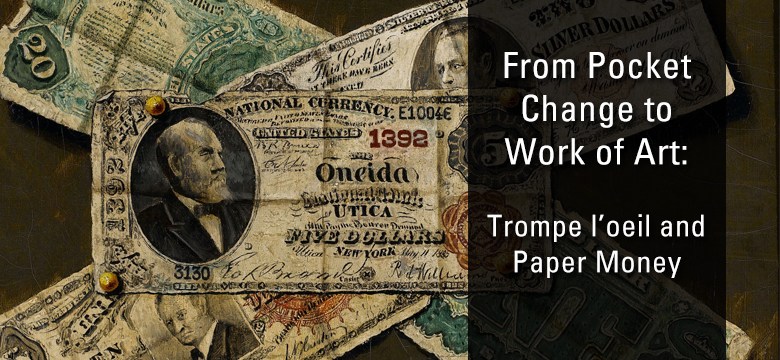
Collectors of American paper money have long appreciated the artistry involved in the carefully engraved and printed designs of U.S. currency. What some collectors may not be as familiar with, however, is the tradition of artists painting paper money as part of their work. Artists such as William Harnett, Victor Dubreuil, Alfred Meurer, and John Haberle developed a uniquely American art form—the trompe l’oeil painting of paper money.
Trompe l’oeil painting is a technique which draws its name from a French phrase meaning “deceive the eye.” This genre was popular in the late 1800s and creates an optical illusion through detailed and realistic imagery that intends to imitate a three dimensional object through the flat medium of a painting. Paper currency became a popular choice for certain American artists not only because of the ease of imitating a thin, flat object such as paper money but also the culturally popular fascination with wealth.
Due to the paper thinness of each banknote, a skilled realist could closely recreate the appearance of a note through the careful manipulation of paint on canvas or board. Trompe l’oeil artists would often paint paper money alone, or even in conjunction with other everyday objects as part of still life scenes. As an example, artist Alfred Meurer exemplifies this theme in his work Still Life With “Times Star,” where he depicts a scene evocative of a gentleman’s study, complete with a newspaper, pipe, glass of wine, books, and various pieces of American paper money. 
The success of these painters, however, occasionally led them to trouble. William Harnett, for example, was so effective in his technique of painting bills and coins that the Secret Service threatened him with arrest for counterfeiting and warned him to discontinue his painting of paper money. In 1886, his work Still Life Five Dollar Bill was seized from the New York saloon where it was hung. Harnett was informed by a judge that “the development and exercise of a talent so capable of mischief should not be encouraged” and moved on to painting other subjects in response.
This did not stop others, such as John Haberle, from continuing to paint American currency in the trompe l’oeil style despite government opposition. Although he was well aware of Harnett’s difficulties with the Secret Service, Haberle parlayed his experience as a skilled draftsman and engraver into the detailed work of illusionistic painting. Imitation, a painting of various coins and paper money including a Large Size note and a piece of Fractional Currency, was exhibited a year after Harnett’s arrest in 1887. From then on, he continued to create many similar works on this theme. He was warned by the Secret Service and Treasury Department about his suspiciously accurate paintings of currency due to fear of counterfeiting, but he continued to paint monetary subjects regardless.
 Yet another skilled trompe l’oeil painter was Victor Dubreuil, whose paintings of barrels of money are well known as examples of the intersection between art and money. Heritage Auctions offered a wonderful example of this realistic style at it applies to American currency a few years ago, with Victor Dubreuil’s American Paper Currency, circa 1889-1891. Although Dubreuil’s work is now seen as a premier example of the art of money painting, his personal background remains somewhat of an enigma. While we know little of this artist’s personal background, art historians agree that he had a strong focus on money and spent most of his artistic career painting it to exacting detail.
Yet another skilled trompe l’oeil painter was Victor Dubreuil, whose paintings of barrels of money are well known as examples of the intersection between art and money. Heritage Auctions offered a wonderful example of this realistic style at it applies to American currency a few years ago, with Victor Dubreuil’s American Paper Currency, circa 1889-1891. Although Dubreuil’s work is now seen as a premier example of the art of money painting, his personal background remains somewhat of an enigma. While we know little of this artist’s personal background, art historians agree that he had a strong focus on money and spent most of his artistic career painting it to exacting detail.
What was once considered a potentially dangerous form of art by the Secret Service and Treasury Department is now treasured among mainstream art collectors and museums alike. In fact, many numismatists over the years have collected such trompe l’oeil works along with their core coin and currency holdings due to the lovely fusion of art and images of wealth that these works display. Works of this genre can be seen at the Metropolitan Museum in New York City, National Gallery of Art in Washington DC, and many other museums as well. Dubreuil, Harnett, and other trompe l’oeil painters reveal to us of the place where an artist’s imagination connects to and elevates the everyday to something truly special, even transforming the crumpled bills in our pockets into art.
By Sarah Miller


I know some one has a $1000 smaii note with Hamilton 1918 7G G17357A I can also attach a photo need the email address
864-437-0964